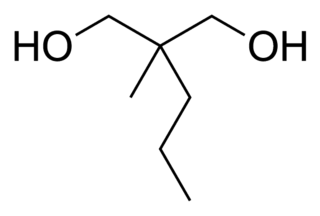A diol is a chemical compound containing two hydroxyl groups. An aliphatic diol may also be called a glycol. This pairing of functional groups is pervasive, and many subcategories have been identified. They are used as protecting groups of carbonyl groups, making them essential in synthesis of organic chemistry.

Fingolimod, sold under the brand name Gilenya, is an immunomodulating medication, used for the treatment of multiple sclerosis. Fingolimod is a sphingosine-1-phosphate receptor modulator, which sequesters lymphocytes in lymph nodes, preventing them from contributing to an autoimmune reaction. It has been reported to reduce the rate of relapses in relapsing-remitting multiple sclerosis by approximately one-half over a two-year period.
Hyperlipidemia is abnormally high levels of any or all lipids or lipoproteins in the blood. The term hyperlipidemia refers to the laboratory finding itself and is also used as an umbrella term covering any of various acquired or genetic disorders that result in that finding. Hyperlipidemia represents a subset of dyslipidemia and a superset of hypercholesterolemia. Hyperlipidemia is usually chronic and requires ongoing medication to control blood lipid levels.

Meprobamate—marketed as Miltown by Wallace Laboratories and Equanil by Wyeth, among others—is a carbamate derivative used as an anxiolytic drug. It was the best-selling minor tranquilizer for a time, but has largely been replaced by the benzodiazepines due to their wider therapeutic index and lower incidence of serious side effects.

Polytrimethylene terephthalate (PTT), is a polyester synthesized and patented in 1941. It is produced by a method called condensation polymerization or transesterification. The two monomer units used in producing this polymer are: 1,3-propanediol and terephthalic acid or dimethyl terephthalate. Similar to polyethylene terephthalate, the PTT is used to make carpet fibers.
1,3-Propanediol is the organic compound with the formula CH2(CH2OH)2. This 3-carbon diol is a colorless viscous liquid that is miscible with water.

Allylic strain in organic chemistry is a type of strain energy resulting from the interaction between a substituent on one end of an olefin with an allylic substituent on the other end. If the substituents are large enough in size, they can sterically interfere with each other such that one conformer is greatly favored over the other. Allylic strain was first recognized in the literature in 1965 by Johnson and Malhotra. The authors were investigating cyclohexane conformations including endocyclic and exocylic double bonds when they noticed certain conformations were disfavored due to the geometry constraints caused by the double bond. Organic chemists capitalize on the rigidity resulting from allylic strain for use in asymmetric reactions.
Ronifibrate is a fibrate, a hypolipidemic agent. It is a combined ester of clofibric acid and niacin with 1,3-propanediol. In the body, the ester is split to 1,3-propanediol and both acids which work in the same way, lowering lipids in blood.

Tybamate is an anxiolytic of the carbamate family. It is a prodrug for meprobamate in the same way as the better known drug carisoprodol. It has liver enzyme inducing effects similar to those of phenobarbital but much weaker.

Sorona is DuPont de Nemours, Inc.'s brand of Triexta, a subclass of polytrimethylene terephthalate (PTT) named and commercialized in 2000. The fibers are soft and stain-resistant while exhibiting high strength and stiffness.

3-MCPD (3-monochloropropane-1,2-diol or 3-chloropropane-1,2-diol) is an organic chemical compound with the formula HOCH2CH(OH)CH2Cl. It is a colorless liquid. The compound has attracted notoreity as the most common member of chemical food contaminants known as chloropropanols. It is suspected to be carcinogenic in humans.
Bioseparation of 1,3-propanediol is a biochemical process for production of 1,3-propanediol (PDO). PDO is an organic compound with many commercial applications. Conventionally, PDO is produced from crude oil products such as propylene or ethylene oxide. In recent years, however, companies such as DuPont are investing in the biological production of PDO using renewable feedstocks such as corn.

Torreyanic acid is a dimeric quinone first isolated and by Lee et al. in 1996 from an endophyte, Pestalotiopsis microspora. This endophyte is likely the cause of the decline of Florida torreya, an endangered species that is related to the taxol-producing Taxus brevifolia. The natural product was found to be cytotoxic against 25 different human cancer cell lines with an average IC50 value of 9.4 μg/mL, ranging from 3.5 (NEC) to 45 (A549) μg/mL. Torreyanic acid was found to be 5-10 times more potent in cell lines sensitive to protein kinase C (PKC) agonists, 12-o-tetradecanoyl phorbol-13-acetate (TPA), and was shown to cause cell death via apoptosis. Torreyanic acid also promoted G1 arrest of G0 synchronized cells at 1-5 μg/mL levels, depending on the cell line. It has been proposed that the eukaryotic translation initiation factor EIF-4a is a potential biochemical target for the natural compound.
1,3-Dioxane or m-dioxane is an organic compound with the molecular formula (CH2)4O2. It is a saturated six-membered heterocycle with two oxygen atoms in place of carbon atoms at the 1- and 3- positions. 1,4-Dioxane, which is of greater commercial value, is an isomer. Both dioxanes are colorless liquids.

Reuterin (3-hydroxypropionaldehyde) is the organic compound with the formula HOCH2CH2CHO. It is a bifunctional molecule, containing both a hydroxy and aldehyde functional groups.
Douglas Carlyle Cameron is an American engineer, inventor, and investor. He is a senior managing director for the U.S.-China Green Fund. He is on the board of the Foundation for Food and Agriculture Research (FFAR) and is a technical and business advisor to organizations including the VTT (Finland), and the Center for Bioenergy Innovation (USA).

Prenderol (Diethylpropanediol) is a simple alkyl diol which has sedative, anticonvulsant and muscle relaxant effects. It is closely related in structure to meprobamate and numerous other alkyl alcohols and diols with generally comparable activity.

2-Methyl-2-propyl-1,3-propanediol (MPP) is a simple alkyl diol which has sedative, anticonvulsant and muscle relaxant effects.

Trimethylolethane triglycidyl ether (TMETGE) is an organic chemical in the glycidyl ether family. It has the formula C14H24O6 and the IUPAC name is 2-({2-methyl-3-[(oxiran-2-yl)methoxy]-2-{[(oxiran-2-yl)methoxy]methyl}propoxy}methyl)oxirane. The CAS number is 68460-21-9. A key use is as a modifier for epoxy resins as a reactive diluent.

2-MCPD (2-chloropropane-1,3-diol) is an organic chemical compound with the formula ClCH(CH2 )2. It is a colorless liquid. The compound has attracted notoreity as a food contaminant. Together with the 3-MCPD, it is one of two chloropropanols food contaminants. It is suspected to be carcinogenic in humans.













